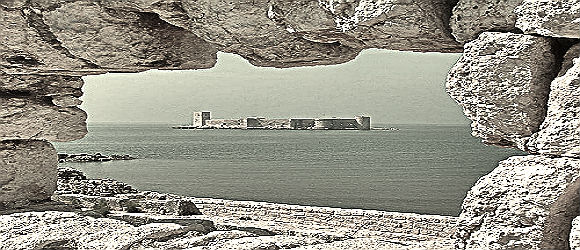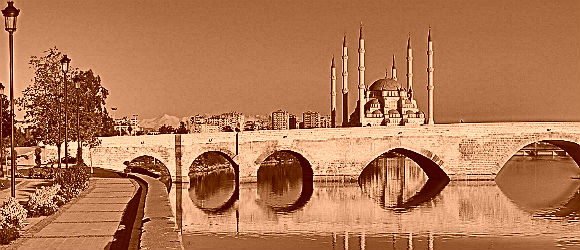Alexander the Great swept through here over 2,000 years ago, and after his death the generals of his army struggled to gain control of his domains. The eastern coast fell to Seleucus I Nicator in the 290s B.C., and he founded an empire along this shore. The Seleucid rulers exerted a great deal of influence in the region until the coming of Rome.
Other empires and kingdoms came and went, but for such a tumultuous history, the eastern shore has surprisingly little to show for it. Silifke (its name is the Turkish form of Seleucia) has one great ruined temple, but is mostly a transportation point, not a tourist destination. From Silifke, buses climb into the mountains for Konya and Ankara. Ferryboats depart from Silifke’s port suburb of Taşucu for northern Cyprus. And buses trundle along the coast through Silifke, Unking Antalya with Mersin and Adana.
Mersin is a modem city less than half a century old. It was built as a port for the important industrial and commercial region of the Çukurova, the Cilician Plain. Adana, though it has a few ancient buildings downtown, is basically a new and modem commercial, industrial, and agricultural center populated by businessmen, workers, and farmers, not tourists. The ancient Roman city of Anti-och, now called Antakya, has somewhat more to hold your interest, as its older section is pronouncedly Arabic or Syrian in flavor, and the Antakya Museum holds Turkey’s most important and striking collection of Roman mosaics.
SİLİFKE: High above this dusty coastal town a fortress broods on its hilltop perch. Between the bus station on the highway and the town center half a mile inland are the ruins of a grand Roman building, the Temple of Jupiter. Silifke is also useful as a place to change buses, or to stay the night if you’re exhausted. The people at the town’s Tourism Information Office, Atatürk Caddesi on the northern side of the Göksu River right at the traffic circle, are helpful and friendly, and have lots of information on Silifke and its hinterland.
- Ferryboats to Cyprus
Passenger ferries depart from Taşucu, a suburb of Silifke, for Kyrenia (Gime) in Turkish Cyprus. Taşucu has its own little Tourism Information Office right at the ferry dock. The Deniz Otobüsü (“Sea Bus,” or hydrofoil) departs Taşucu on Monday, Wednesday, and Friday at 10 a.m. on the two-hour trip to Kyrenia. Besides the hydrofoil there are regular steamers which cany cars as well as passengers, operated by the on Tuesday, Thursday, and Saturday at 10 a.m. The trip on the car-feny takes six hours.
- Onward from Silifke
Heading north, the bus to Konya takes 4 hours to Ankara, the bus trip takes eight hours. The bus route eastward from Silifke to Mersin (53 miles, 85 km), Tarsus and Adana (95 miles, 153 km) has lots of traffic, so you should have no trouble finding a seat. The Silifke Koop company runs buses about every 15 minutes throughout the day.
The most exciting event on the coastal ride is your first sight of the Kız Kafesi (“Maiden’s Castle”), a wondrous castle floating above the azure Meditena-nean waters about a mile offshore. Another castle faces it from the shoreline. Both were supposedly built in Roman or Byzantine times.
If you have your own car, head inland opposite the village of Narhkuyu for a look at the great limestone caverns named Cennet ve Cehennem (“Heaven and Hell”).
MERSİN : Unless you need a bed, or are going to take your car on the big Turkish Maritime Lines fenyboat to Cyprus, you have little reason to stop in Mersin. If you do stop, however, head for the Tourism Information Office, İnönü Bulvari.
Car-Ferries to Cyprus
Turkish Maritime Lines operates the M/F Yeşilada car-ferry from Mersin to Famagusta (Magosa) all year, departing Mersin on Monday, Wednesday, and Friday at 10 p.m. on the ten-hour cruise.
Onward to Adana
The T. O. K. bus company operates a shuttle service between Mersin and Adana, with buses departing Mersin’s bus station every 15 or 20 minutes throughout the day.
Just 17 miles east of Mersin along a fast highway lies the industrial town of Tarsus, where Paul the Apostle was born almost 2,000 years ago. Virtually nothing is left of ancient Tarsus, certainly nothing to help you to feel that you are traveling “in the in the footsteps of St Paul.” The best you can do is look at the landscape and ponder how it might have been almost two millennia ago; but the industrial scenery doesn’t help you out much.
ADANA: The Cilician Plain, or Çukurova, north of Adana, is a marvekmsly fertile agricultural region. Of all its crops, cotton is king, and the wealth from cotton cultivation has made Adana rich during the last few decades.
With the income from cotton, local entrepreneurs have begun industries and commercial concerns that contributed even more to Adana’s explosive growth. Today it’s Turkey’s fourth-largest city, and still growing fast.
The speed of Adana’s expansion hasn’t left much time for planning or architectural niceties, so it’s not a particularly attractive city. But it is a transportation hub, and it does have one or two places which you will want to visit.
- Getting There
As one of Turkey’s most important cities, located right near the pass through the Taurus Mountains known as the Cilician Gates, Adana is the crossroads of the southeast.
Turkish Airlines, Stadyum Caddesi 1 runs two nonstop flights a day between Adana and Istanbul ( 4 hours), and also between Adana and Ankara (one hour). There is airport bus service from Adana’s Şakirpaşa Airport into the center of town.
Adana’s Otogar has direct buses to and from most major cities, including Adıyaman and Kahta, near Nemrut Dağı (seven buses per day; six hours, Antalya (eight hours Alanya, Diyarbakır nine hours;, Konya, and Şanlıurfa six hours. Adana is also a major rail junction, with six trains a day westward akmg the coast to Mersin and express trains northward to Kayseri, Ankara, and Istanbul.
- Orientation
The airport is two miles west of downtown, just off the main highway. The highway itself roars right through the center of town and passes the Otogar before crossing the Seyhan River, which borders the eastern edge of the downtown area. Adana’s train station is at the northern end of the broad boulevard named Ziya Paşa Bulvari, a mite or so north of downtown. To get into town, take a bus from the airport, a taxi from the train station. From the Otogar, take a taxi or a bus, or walk for 20 minutes if your bags aren’t too heavy.
When you get downtown, you will discover that the main street is inönü Caddesi. It’s not particularly wide or impressive, but it has most of the citys recommendable hotels, several restaurants, and its prettiest museum. The Tourism Information Office, Atatürk Caddesi 13 is just halfa block north of İnönü Caddesi along Atatürk Caddesi.
- Museums
While you’re here, be sure to see the Adana Ethnography Museum or Adana Etnografya Müzesi on a little side street just to the left of the Adana Sürmeli Oteli. Though the exhibits of Turkish carpets, swords, manuscript books, and tombstones are interesting, the building is even more so. It was built by the Crusaders as a church, and is in that attractive, plain but harmonious Burgundian style of early medieval France. The church was used until the present century, when it became a museum. The museum is open from 9 a.m. to noon and 1:30 to 5:30 p.m., closed Monday; admission costs half price on Sunday.
The Adana Regional Museum, or Adana Bölge Müzesi, is more the standard archeological museum found in most Turkish towns. The modem glass-and-concrete museum building holds lots of statuary and a few mosaics, as well as the other standard produce of local archeological digs. It’s very near the Otogar, right on the riverbank. You can visit any day but Monday from8:30a.m. to 12:30p.m. and 1:30 to5:30p.m.
Adana’s other noteworthy sight is the Roman stone bridge across the river, called the Taşköprü. It’s still in use, and, begrimed by the traffic, is not all that impressive, though it might be if it were a well-preserved footbridge in a nice park. Looking at it, you must remember that building a stone bridge 300 yards long was quite a feat in Roman times.
Turkey's eastern Mediterranean shore has seen an awful lot of history. ,


